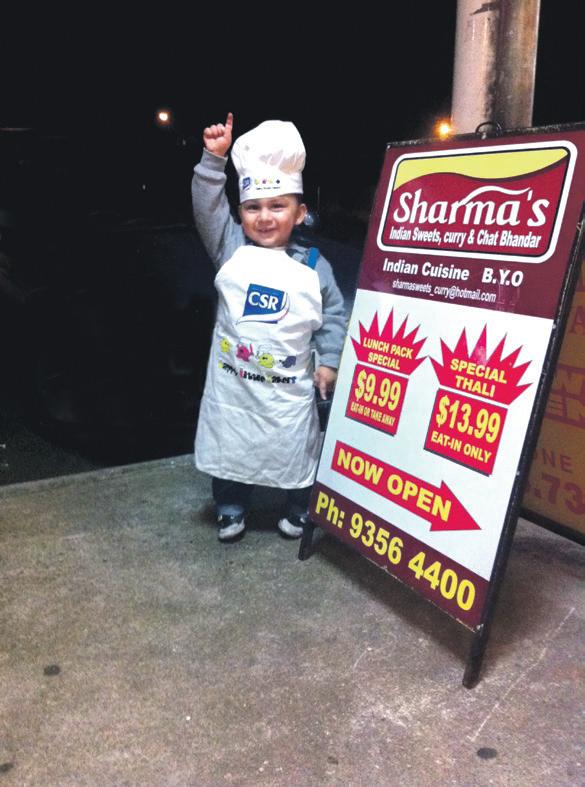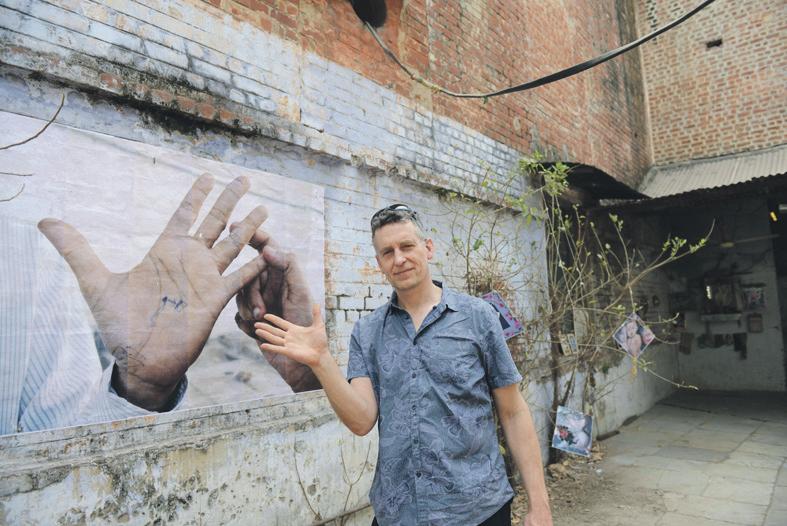
12 minute read
SHARMA’S indian SWEETS
from 2013-05 Melbourne
by Indian Link

Now a Shariah Index for financial inclusion of Indian Muslims
Followers of Islam, the second largest faith in the world with an estimated 1.7 billion believers, can now be surer when an Indian firm stands the pre-requisites for observant Muslims. The Shariah index launched by the Bombay Stock Exchange (BSE) recently is a new measure in town, assuring compliance with the Islamic canonical law.
Besides giving Islamic mega funds a surer handle on Indian markets, the aim of the S&P BSE 500 Shariah Index is financial inclusion of Indian Muslims - around 177 million in number and hitherto wary of stock markets - and attract them to “correct” equities.
“For us, the index is part of a bigger exercise - of inclusion and fairness,” said Ashishkumar Chauhan, managing director of BSE and an alumnus of the Indian Institute of Technology and the Indian Institute of Management who spent his early years in Ahmedabad.
“The ‘maahoul’ (composite culture and environs) in the city influenced my appreciation of ‘inclusion’ as an imperative,” said Chauhan in an interview, who in the past headed an Indian Premier League franchise. Last month, the BSE Institute, a wholly owned subsidiary of the exchange, in association with Taqwaa Advisory and Shariah Investment Solution, announced an online certification programme in “Islamic Banking, Finance and Capital Markets”. Chauhan bets there is a big market for students who have an understanding of the latest developments in the fields of Islamic banking, finance and the capital markets.

Islamic banking and finance extends to some 75 countries, growing at over 15 percent per annum. To be able to sustain its growth, the industry needs large numbers of banking and finance professionals who require training about its basic principles and practices.
This list includes fund managers, chief financial officers, merchant bankers, corporate financial advisors, portfolio managers, product development managers, finance marketing professionals, chartered accountants, stock brokers, wealth and fund managers, students and researchers.
Globally, S&P Dow Jones is big on Islamic financing. In its existing partnership with Ratings Intelligence Partners, boasting a crew of Islamic finance jocks and theologists on its board, S&P offers a variety of Islamic indices such as S&P Global BMI Shariah, with an adjusted market capitalisation of $15.183 billion; S&P Developed BMI Shariah, with an adjusted market capitalisation of $13.340 billion; and S&P Developed LargeMidcap Shariah, adjusted market capitalisation $11.554 billion.
These are among 11 others encompassing Africa, Asia-Pacific, Europe and North America. Befittingly, after S&P and the BSE entered into a tie-up this February, the index is their first new product. Ratings Intelligence Partners remains the knowledge driver.
Each of the BSE indices, including the iconic BSE Sensex, bellwether of India’s market economy comprising 30 top stocks, already stand co-branded under an “S&PBSE” banner.
The preferred Islamic investment format is equity, as interest is forbidden. Yet, giving due currency to the exigencies of modern businesses, particularly the pervasiveness of interest-based transactions, Shariah scholars have a minimum compliance criteria.
These criteria, while excluding companies in gross violation, also provide investors a reasonable choice of Shariah-compliant equities. These minimum guidelines, however, are not uniformly applied by all Shariah advisors.
Companies dealing with pork, alcohol, gambling, tobacco, telecom, advertising and media, with some exceptions, are left out of Islamic indices. So are banks as Islamic investors are not allowed to profit from interest. Similarly, firms with certain financial ratios - like a debt of more than 33 percent to the market value of equity - do not make it to Islamic indices.
But companies, whose involvement in non-permissible businesses is less than five percent of total revenue, do qualify. These calculations are monitored and status updated from time to time.
Besides curbs on interest and debt, Islamic funds cannot pay fixed or guaranteed return on capital. Instead of borrowing or lending, Islamic finance relies on shared ownership of assets and therefore risk in the form of profit or loss. As Islam forbids gambling, derivatives, forwards, options and futures trading are also prohibited - so are shortselling, margins and scalping trading. Day trading is also considered akin to gambling.
Data from djindexes.com shows the Dow Jones Islamic World Index has an adjusted market cap of $13.254 billion. The FTSE Shariah All-World Index stood at $15.586 billion. All this suggests the potential in India, where the BSE had a market capitalisation of $1.2 trillion from over 5,100 listed stocks in 2012-13, is fairly large.
Thus far, despite having the second-largest population of Muslims on the planet, Indian markets had a dearth of scientific ways to tell if the investee company eschews what’s repugnant in Islam. The financial exclusion of Indian Muslims also remained a faultline and the walk to mend it hardly matching the talk. Now there is hope, and promise.
Gene causing motor development disorder found
In a discovery that is paving the way for the diagnosis and treatment of a rare genetic disorder related to the brain’s functioning, a team of researchers has identified the causative gene behind the disease, which delays development of motor activities in children.
The study was done on a four-yearold child from Punjab, and nine other children who were suffering from motor developmental delay. They could not walk and sit without support.
The team, led by Ryan Taft of the University of Queensland’s Institute for Molecular Bioscience (IMB), comprised 16 researchers including I.C. Verma, director, Centre for Medical Genetics, Sir Ganga Ram Hospital and Monica Juneja, Department of Paediatrics, Maulana Azad Medical College.
The doctors used genome sequencing to determine that these children were suffering from a defect in a gene previously not associated with human disease.
“It has been found that mutations in a gene called DARS gene is responsible for causing inherited brain disorder called HBSL (Hypomyelination with Brain Stem and Spinal Cord Involvement and Leg Spasticity), which affects the motor development activities,” a statement from the doctors said.
“We analysed the genome sequences of this child and his parents, using a method called whole genome sequencing and found that a mutation in the DARS gene was likely causing the disorder,” Taft said.
“In collaboration with clinicians from India, Canada, Netherlands, Australia, and the US, we then examined the genomes of nine other children who appeared to be suffering from the same disease and the genomes of their parents, and confirmed that they all had mutations in the DARS gene,” he said.
“This gene has never previously been associated with human disease and may not have been identified as the culprit using any other method,” said Verma, who heads the department of genetics at Sir Ganga Ram Hospital.
Experts from Sir Ganga Ram Hospital and Maulana Azad Medical College, Delhi, India and IMB in Brisbane, Vrije Universiteit Medical Center in Amsterdam, Murdoch Children’s Research Institute and The Royal Children’s Hospital in Melbourne, and Children’s National Medical Centre in Washington D.C came together for this research.
Verma elaborated: “They have named the disease HBSL because it causes Hypomyelination in the brain stem and spinal cord, leading to leg spasticity. Hypomyelination occurs when people do not have enough myelin, the substance that coats nerve fibres and enables the transmission of electrical impulses in the nervous system”.
“Our goal is to dramatically reduce the number of unresolved paediatric cases of the rare genetic disease,” said Taft.
The technology of exome sequencing and whole sequencing now allows doctors to find the cause of disease in many children with unknown brain disorders. The doctors say they have used exome-based targetted next generation sequencing to identify the culprit gene in other patients also.
At present 30 to 40 percent of patients with intellectual disability go undiagnosed in India. Doctors say the new techniques will remarkably reduce this number.
“Discovering the causative gene will help in providing genetic counselling to the family. It will also ensure that they have normal children,” Verma said.
“This is the future of medicine - doctors, including clinical specialists like MRI experts - and genomics researchers working together to diagnose and develop treatments for people with unknown diseases,” he added.
Iran proposes joint investment, new oil contract to India
Iran proposed to India joint investments and a production sharing contract for oil exploration as the two countries agreed to expand cooperation in the transportespecially cargo transit from Chabahar port to Afghanistan and energy sectors and building the North-South corridor linking Russia.
Meeting under the aegis of the Iran-India Joint Economic Commission in Tehran recently, the two sides agreed to work on a trilateral transit pact involving India, Iran and Afghanistan.
Iranian Foreign Minister Ali Akbar Salehi said the abundant commonalities and cultural affinity between the two countries served a solid base for joint investment.
He said Iran was ready to expand cooperation with India in the fields of agriculture, industry, telecommunications and education on bilateral, multilateral and regional levels.
The oil offer is significant as Iran is hit by US and European sanctions. It has so far been offering service contracts to foreign companies, allowing a fixed fee for exploring and producing oil. The contours of the production sharing proposal was not immediately clear, but is believed to envisage possible ownership of the oil explored and produced by firms and the freedom to ship it wherever they like.
India’s External Affairs Minister Salman Khurshid reiterated India’s decision to participate in the upgrade of Chahbahar port. The secretary in the shipping ministry would travel to Tehran soon for negotiations on costs and other issues.
The Chahbahar port, surrounded by a free trade zone, is critical for India as Pakistan does not allow transit facilities to Afghanistan.
The Iranians said the Chahbahar project was important not only for their country and Afghanistan, but also for Central Asia.
Khurshid called for more contacts between the private sectors in the two countries as well as academic and educational cooperation.
The two countries discussed ways to enhance two-way trade and people-to-people contact, liberalising the visa regime. It was felt that the volume of trade did not reflect the close relations between the two countries and identified agriculture and pharma products and aeronautics the areas where cooperation could be stepped up.
“We are determined to explore and use all capacities for economic cooperation and that Tehran-New Delhi joint economic commission is of high importance for preparation of the ground, removal of impediments and follow up the agreements already reached,” the official Iranian news agency IRNA quoted Khurshid as saying.
Iran and India also reviewed the NorthSouth corridor which will link Russia with Iran, with Khurshid saying that all hurdles should be resolved.
Both sides also discussed the security situation in Afghanistan and agreed to remain in regular contact.
Iran’s controversial nuclear programme also came up during the meeting and Salehi said talks with P5+1 would resume this year.
On Syria, both countries asked all sides involved in the conflict to abjure violence and supported the Geneva Communique which includes the 6-Point Plan of Kofi Annan and welcomed the efforts of Joint Special Envoy Lakhdar Brahimi.
Khurshid also called on President Mahmoud Ahmadinejad and met Ali Akbar Velayati, advisor to the Supreme Leader Ayatollah Seyyed Ali Khamenei and Majlish speaker Ali Larijani.
Khurshid also inaugurated the Indian Cultural Centre in the Iranian capital.
hornbill conservator aparajita Datta gets Whitley award
Conservator Aparajita Datta has won the Whitley Award, also called “Green Oscar,” for her work to save threatened hornbills in the forests of Arunachal Pradesh.
Datta is one of eight grassroots conservation leaders awarded a share of prize funding worth $295,000 by the Whitley Fund for Nature.
Datta leads a programme to conserve hornbills in the Eastern Himalaya at the Nature Conservation Foundation (NCF), an NGO set up in 1996 to promote science- based wildlife conservation in India.
“Focusing on hornbills as a conservation flagship species, she is seeking to improve the status of the bird’s populations outside protected areas by establishing models of community-based conservation,” the Whitley Fund said.
“Datta is spreading knowledge of the needs of hornbills and their importance, as seed dispersers, in the maintenance of healthy forest ecosystems. Key to her approach is raising awareness of the threats to the bird’s survival, and creating a wider rural and urban constituency for conservation through a participatory community outreach programme that gets people involved,” said the fund.
Datta has been monitoring 60 hornbill nests in Arunachal Pradesh.
Datta will use the prize money to conduct surveys in Assam, Meghalaya, Mizoram and Nagaland to figure out the status of hornbills. This will help to create an ideal model to conserve hornbills outside protected areas.
Princess Anne, daughter of Queen Elizabeth II, presented the award at a ceremony at the Royal Geographical Society in London recently.
mumbai surgeon wins Us award for anti-tobacco campaign
Panjak Chaturvedi, a cancer surgeon at Mumbai’s Tata Memorial Hospital, has won a prestigious US award for his innovative leadership in the fight to reduce tobacco use and tobacco-related disease in India.
The Campaign for Tobacco-Free Kids presented Chaturvedi with the Judy Wilkenfeld Award for International Tobacco Control at its annual awards gala in Washington recently.
The Wilkenfeld Award was established in honour of Judy Wilkenfeld, the founder of Tobacco-Free Kids’ international programme, who passed away in May 2007.
The award recognises international tobacco control advocates who contribute significantly to reducing tobacco use and inspire others to do the same in the spirit exemplified by Wilkenfeld.

“We have seen great progress in India and hope to serve as an example for the global community,” said Chaturvedi accepting the award.
“The world must hear the voice of tobacco’s many victims and know that progress in the global fight against tobacco is possible”.
“Cancer specialists like me who work with tobacco victims are the constant witnesses of the crimes perpetrated by the tobacco industry,” Chaturvedi said.
“I could no longer sit back and watch how helpless my patients and their families felt. I hoped these victims’ personal stories would rock the consciences of policy makers who must be convinced to take action.”
“Dr Chaturvedi has not only created a lasting legacy in India, but also provided a global example in combating tobacco use,” said Matthew L. Myers, President of the Campaign for Tobacco-Free Kids.
As a head and neck cancer surgeon at one of India’s leading cancer hospitals, Chaturvedi was motivated to act by the suffering of patients with tobacco-caused cancers.
Described by his colleagues as visionary, tireless and undaunted, Chaturvedi recognised that fundamental change wouldn’t happen until public figures had to confront the horrifying reality that he sees every day in his operating room, according to a media release.
So Chaturvedi “launched the Voice of Tobacco Victims campaign. This revolutionary campaign has mobilised tobacco victims and their doctors to confront India’s leaders and demand that they enact and implement strong tobacco control laws,” the release said.
Today, this group is one of the leading forces behind India’s growing tobacco control movement that has resulted in bans of smokeless tobacco products in 23 of India’s 28 states and five of seven union territories.
It has also contributed to tobacco tax increases in 20 states.
marry outside caste in himachal, get rs.75,000!
While ‘khap panchayats’ (caste councils) in Haryana continue to frown on inter-caste and sub-caste marriages and punish those who do so, marrying outside one’s caste is ever so profitable in neighbouring Himachal Pradesh - it’ll get couples all of Rs.75,000.
To prompt young men and women to break the caste barrier, the cabinet headed by Chief Minister Virbhadra Singh has enhanced the inter-caste marriage incentive from Rs.25,000 to Rs.75,000. It’s given to couples where one of the spouses belongs to a Scheduled Caste.
“We have seen in the past few years that the cash incentive of Rs.25,000 was not encouraging too many couples. So we have decided to make it lucrative by doubling its amount,” Special Secretary (Social Justice and Empowerment) M.P. Sood said recently in Shimla.
Departmental records show that only 1,113 inter-caste marriages materialised in the past four years.
In 2012-13, 277 couples got the incentive, 304 in 2011-12, 300 in 2010-11 and 232 in 2009-10.
The Himachal Pradesh government introduced the scheme in 1994.
“Now, we are expecting more and more young couples, especially women, will come forward to break the caste barrier,” Sood added.
Newlywed Shimla-based Aneesh and his wife Shweta believe that the choice is for the man and the woman to make. Aneesh, a handsome banker, belongs to a lower caste, while Shweta is a high-caste Brahmin.
“It’s you who spends your whole life with the partner, not your parents. Your decision is final,” Aneesh said.
“In our case too, we convinced our parents and finally they agreed. But we were lucky as many still get threatened or even murdered for this,” Shweta added.
Rameshwar Sharma, additional director of the social justice and empowerment department, said the state is expanding opportunities for the Scheduled Castes, who constitute 24.72 percent of state’s 6,856,509 population.
“Promoting inter-caste marriage is just one step in destroying the caste system,” he added.
The Supreme Court in 2011 held that inter-caste marriages are in the national interest. Justices Markandeya Katju and Gyan Sudha Misra said: “The caste system is a curse on the nation and the sooner it is destroyed the better. In fact, it is dividing the nation at a time when we have to be united to face the challenges. “Inter-caste marriages are, in fact, in national interest as they will result in destroying the caste system,” the court added.
The court held that diktats by the “khap panchayats” aimed at coercing or committing atrocities on young men and women who wish to marry inter-caste/religion were illegal and should be stamped out.









